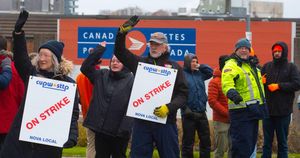Streets throughout the Middle East have erupted with demonstrations as people voice their outrage over the latest escalation of violence between Israel and the Palestinian territories, marked by alarming civilian casualties. The protests, which have swept across various Middle Eastern nations, have taken various forms, from marches to rallies, all expressing solidarity with those affected by the Israeli military actions. This surge of protests coincides with the intensification of military campaigns and rhetoric surrounding the Israel-Palestine conflict, bringing forth passionate and sometimes heated responses from local populations, regional leaders, and international observers.
Most prominently, large rallies were held on Friday, November 15, 2024, across Yemen. Thousands gathered in Sana'a and other provinces like Sa’ada and Hajjah, waving flags of Yemen, Palestine, and Lebanon, chanting phrases of solidarity including phrases emphasizing their support for Gaza and Lebanon. Yemenis expressed their vehement opposition to what they termed 'American imperialism and its support for Israeli aggression.' The protesters carried banners and shouted slogans like “Oh Gaza, you are not alone,” demonstrating deep-rooted resentment toward the longstanding Israeli-Palestinian conflict.
Yemen’s protests were not just confined to words. A statement from the organizers hailed Yemen’s Ansarullah resistance movement for their military actions against Israeli vessels and U.S. naval assets. These operations, according to the leaders, are seen as retaliatory actions against perceived aggressors. This sentiment reflects the greater struggle many Yemenis feel against regional and Western powers involved in the Middle East. The demonstrations have grown larger and more frequent since the outbreak of hostilities on October 7, 2023, which saw Israel launch its military operation, responding to the surprise attack from Hamas called Operation Al-Aqsa Storm.
Meanwhile, similar fervor ignited protests across Iraq, where demonstrators took to the streets of Baghdad, burning flags representing the U.S., U.K., and Israel. Protests surged after Friday prayers, symbolizing widespread dissatisfaction and anger directed not just at Israel but at Western powers seen as complicit. The fervor of the rallies echoed through neighborhoods like Sadr City, where protesters burned the flags of Western nations, joining Palestinian and Lebanese flags as symbols of their discontent. The rhetoric was incendiary, with slogans such as “No, no for Israel. Yes, yes for Islam” permeated the chants of the participants.
Among the voices raised at these demonstrations were Iraqi politicians like Hakim al-Zamili, who condemned the continued violence, stating, “We have decided to speak against the Zionist and American crimes of killing children, women, and elderly people.” His remarks provided insight not just on the protests’ local dynamics but also on the broader narrative at play within the region — one where many perceive Israel's actions as indicative of systemic aggression not just against Palestinians but against its neighbors and their populations.
The gravity of the situation on the ground has not gone unnoticed internationally. Analysts and local media outlets have reported increasingly dire conditions for civilians caught up in the conflict. The reported death toll from the violence speaks volumes: over 43,700 Palestinians, primarily women and children, have been killed since the onset of military operations, exacerbated by Israeli airstrikes on Gaza and continuing tensions with Lebanon. These statistics resonate during the protests, adding emotional weight as advocates call for global support and intervention.
These demonstrations across the region have drawn attention to the perceived failures of Arab nations to act decisively against Israeli incursions, prompting significant frustrations among the populace—frustrations leading to public demonstrations. Many are calling for unified action and solidarity to combat what they view as overwhelming military aggression against defenseless populations.
Some protestors also channeled their anger toward local governments, insisting on collective accountability and action, as seen through several commentators who criticized Arab leadership's inertia. Quotes captured from various gatherings emphasized this anger and disillusionment, with protestors demanding “real action, not just words” from their leaders during this crisis.
Across the region, countries with significant Palestinian populations, like Jordan, also experienced demonstrations echoing similar sentiments. Protesters there also voiced their discontent with Israel’s policies and military actions, particularly the reported blockade on humanitarian aid efforts and the mistreatment of the Palestinian people. They firmly expressed their solidarity for the Palestinians and called upon their government to take action.
The Israeli government maintains its stance, asserting national security and the necessity for military action against perceived threats from Hamas and other militant groups within and bordering its territories. This has led to increased military readiness and deployment along the borders, particularly toward Gaza, eleving tensions not just locally but across the entire region.
Critics within and outside Israel, including various NGOs and human rights organizations, have condemned the Israeli military's tactics, citing overwhelming force used to target civilian areas. The justification provided by military leaders is often met with skepticism, raising significant moral and ethical questions as protests worldwide begin to resonate against the actions taken by Israel.
Protests have also gained traction among university campuses across North America and Europe, where students and workers demonstrated to highlight their disdain for Israeli military tactics. Many are demanding their institutions cut ties with financial and military sponsors, arguing for ethical investments and university policies embracing human rights standards.
Meanwhile, global leaders have begun to respond, with diplomatic channels opening as pleas for ceasefire agreements and humanitarian aid escalates. Nations have called for immediate intervention, and humanitarian corridors to be established to assist those trapped within Gaza and Lebanon, where food, water, and medical supplies have become scarce.
With the conflict continuing to evolve and public sentiment intensifying, it remains to be seen how these protests will shape political discourse not just regionally but globally. Advocates for peace continue to rally for respect, dialogue, and mutual recognition across borders, emphasizing common humanity over political tensions.
The movements ignited by these protests might serve as both critique and catalyst for action, reshaping future policy decisions among neighboring countries, calling for sharper delineation between political allies and armed violence with civilian consequences. The world watches closely as these sentiments influence international relations and regional stability, hoping for resolutions rooted more firmly in compassion than aggression.



